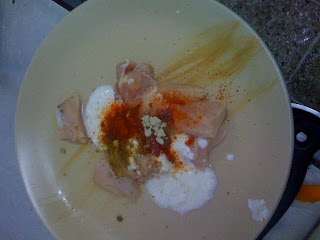Wednesday, October 15, 2008
Hong Kong in pictures
Tuesday, October 7, 2008
A discourse on Tibetan / Nepali carpets
Saturday, October 4, 2008
Recipe: Nepali-Indian mushroom matar


Recipe: Nepali-Indian Chicken Masala
On the chicken breast, sprinkle the curd, chat masala, chili powder, and lime juice. Mix, and add salt, white pepper, and red coloring (optional).
In a stir-fry pan with oil under medium heat, braise the chicken by leaving the pieces (not the entire marinade) on the pan until each side is golden-brown (flip). This may take up to 10 minutes. Remove from flame when finished.
While the chicken is braised, add 1 cup water, the curry powder and the cumin powder to the leftover marinade. Add more coloring (optional), and the salt and MSG (optional).
In a separate stir-fry pan under medium heat with oil, add the onion. Stir fry until brown, and then add finely diced tomato, along with butter and the leftover marinade. After a minute, add the cilantro and leftover tomato. Add the cooked chicken. Cook two minutes, adding water if necessary, and add the juice of the other lime half. Remove all of the contents of the pan but the oil; serve.
The chicken before red coloring is added
Braising the chicken
The marinade post-chicken and post-later additions, ready to be stir-fried

Note: when stir-frying, water should be used if the mixture becomes too dry or burns; let it boil off to keep a broth consistency. The base sauce in this looks like tomato, onion, curd, and the spices, as opposed to the typical tomato and/or onion and/or garlic and/or garam-masala base, and the curd is probably the emulsifier.
Recipe: Nepali Chili Chicken
All but the bell peppers, and actual use was half of the hot sauce pictured. Also, the batter.
Make the batter by mixing all ingredients above (the egg needs not be prepared), and make sure it is a smooth but firm consistency. Then, dip the chicken into the marinade and spread evenly (there will be ample leftover sauce). Deep fry the chicken, sauce excluded, for ten or so minutes or until cooked. Then, add the onion slices, bell pepper slices, and fry 30 more seconds. Drain and set aside.
In a stir-fry pan on medium heat, stir-fry with oil and garlic for 30 seconds; add tomato and the chilies. At this point the garlic should start to brown. Add water to keep from drying, 1 tbsp ketchup, and the hot sauce. Then, add the non-batter1/2 tsp salt, MSG (optional), and 1/2 tsp black pepper. The mixture should look like a broth. Add in the deep fried chicken and vegetables. At this point, add water as necessary so the mixture does not get dry. Finally, emulsify the broth by adding corn starch in water. Serve with raw onions on top or lightly cooked.
Right after adding the chicken
Note: when stir-frying, water should be used if the mixture becomes too dry or burns; let it boil off to keep a broth consistency. Also, I'd imagine soy sauce or vinegar can be added to taste to make it more East Asian.
Serves 1
Thursday, October 2, 2008
Annapurna and Dhaulagiri, in pictures






Wednesday, October 1, 2008
Recipe: Nepali Dal Bhat
















